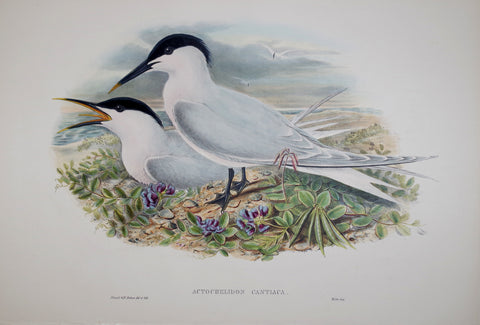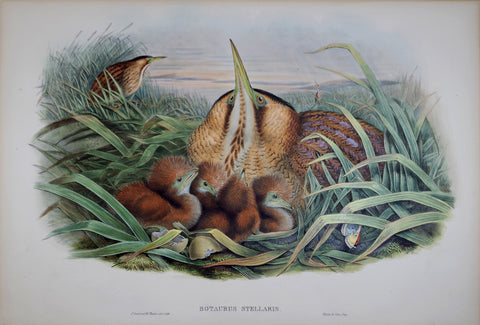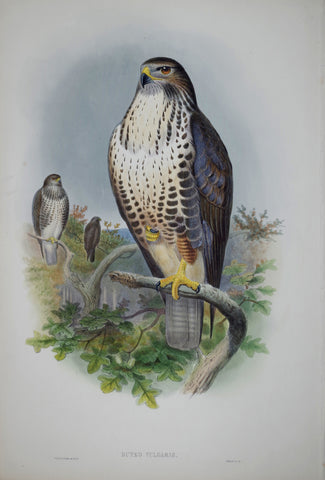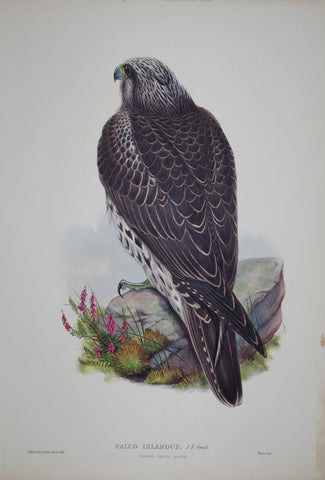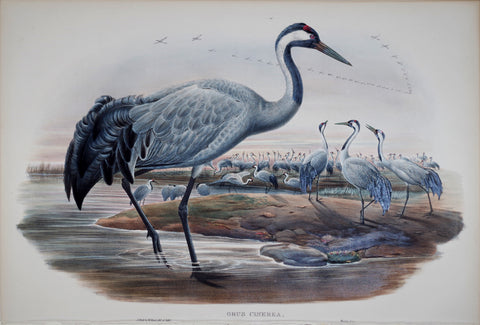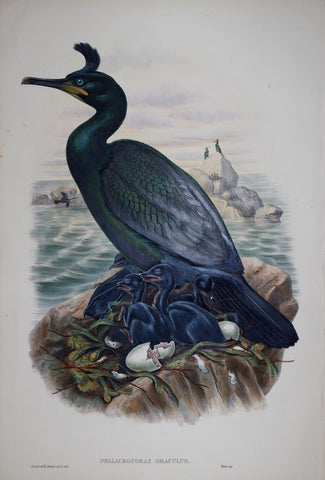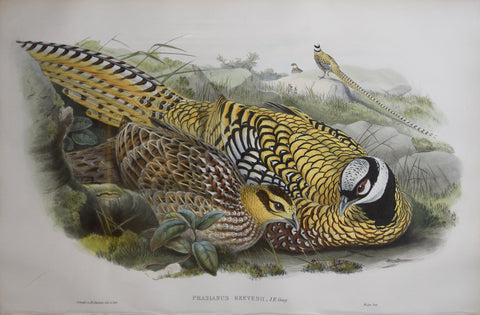Search By Artist
John Gould (1804-1881), Birds of Great Britain
The Birds of Great Britain.
London: Taylor and Francis for the author, [1862]-1873.
Lithographs with original hand-coloring.
Often referred to as the most sumptuous and costly of all British bird books, the plates depict scenes with more sophisticated subjects than Gould's previous works, including nests, chicks and eggs: "I also felt that there was an opportunity of greatly enriching the work by giving figures of the young of many of the species of various genera - a thing hitherto almost entirely neglected by author's, and I feel assured that this infantile age of birdlife will be of much interest for science." (Gould "Preface" to "Introduction", 1873).
Initially employed as a taxidermist [he was known as the 'bird-stuffer'] by the Zoological Society, Gould's fascination with birds began in the "late 1820s [when] a collection of birds from the Himalayan mountains arrived at the Society's museum and Gould conceived the idea of publishing a volume of imperial folio sized hand-coloured lithographs of the eighty species, with figures of a hundred birds (A Century of Birds Hitherto Unfigured from the Himalaya Mountains, 1830-32).
Gould's friend and mentor N. A. Vigors supplied the text. Elizabeth Gould made the drawings and transferred them to the large lithographic stones. Having failed to find a publisher, Gould undertook to publish the work himself; it appeared in twenty monthly parts, four plates to a part, and was completed ahead of schedule. "With this volume Gould initiated a format of publishing that he was to continue for the next fifty years, although for future works he was to write his own text. Eventually fifty imperial folio volumes were published on the birds of the world, except Africa, and on the mammals of Australia-he always had a number of works in progress at the same time. Several smaller volumes, the majority not illustrated, were published, and he also presented more than 300 scientific papers. "His hand-coloured lithographic plates, more than 3300 in total, are called 'Gould plates'. Although he did not paint the final illustrations, this description is largely correct: he was the collector (especially in Australia) or purchaser of the specimens, the taxonomist, the publisher, the agent, and the distributor of the parts or volumes. He never claimed he was the artist for these plates, but repeatedly wrote of the 'rough sketches' he made from which, with reference to the specimens, his artists painted the finished drawings. The design and natural arrangement of the birds on the plates was due to the genius of John Gould, and a Gould plate has a distinctive beauty and quality. His wife was his first artist. She was followed by Edward Lear, Henry Constantine Richter, William Matthew Hart, and Joseph Wolf" (Gordon C. Sauer for DNB).
Initially employed as a taxidermist [he was known as the 'bird-stuffer'] by the Zoological Society, Gould's fascination with birds began in the "late 1820s [when] a collection of birds from the Himalayan mountains arrived at the Society's museum and Gould conceived the idea of publishing a volume of imperial folio sized hand-coloured lithographs of the eighty species, with figures of a hundred birds (A Century of Birds Hitherto Unfigured from the Himalaya Mountains, 1830-32).
Gould's friend and mentor N. A. Vigors supplied the text. Elizabeth Gould made the drawings and transferred them to the large lithographic stones. Having failed to find a publisher, Gould undertook to publish the work himself; it appeared in twenty monthly parts, four plates to a part, and was completed ahead of schedule. "With this volume Gould initiated a format of publishing that he was to continue for the next fifty years, although for future works he was to write his own text. Eventually fifty imperial folio volumes were published on the birds of the world, except Africa, and on the mammals of Australia-he always had a number of works in progress at the same time. Several smaller volumes, the majority not illustrated, were published, and he also presented more than 300 scientific papers. "His hand-coloured lithographic plates, more than 3300 in total, are called 'Gould plates'. Although he did not paint the final illustrations, this description is largely correct: he was the collector (especially in Australia) or purchaser of the specimens, the taxonomist, the publisher, the agent, and the distributor of the parts or volumes. He never claimed he was the artist for these plates, but repeatedly wrote of the 'rough sketches' he made from which, with reference to the specimens, his artists painted the finished drawings. The design and natural arrangement of the birds on the plates was due to the genius of John Gould, and a Gould plate has a distinctive beauty and quality. His wife was his first artist. She was followed by Edward Lear, Henry Constantine Richter, William Matthew Hart, and Joseph Wolf" (Gordon C. Sauer for DNB).
Anker p. 60; "Fine Bird Books"; Nissen 372; Sauer 23; Tree "The Ruling Passion of John Gould", p. 207; Wood p. 365; Zimmer p. 261.

